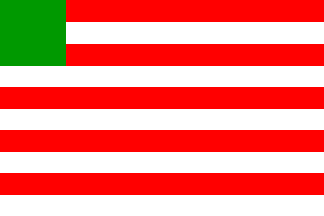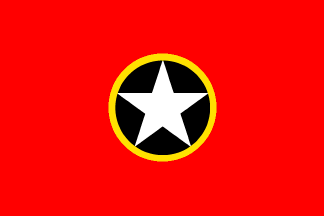
This page is part of © FOTW Flags Of The World website
Union of the Republic / United Republic of Timor (1961)
Last modified: 2023-06-03 by  zachary harden
zachary harden
Keywords: union of the republic | united republic of timor | bureau de luta pela libertação de timor | star: 5 points (white) | stripes: 10 (red and white) | square: green | mao klao |
Links: FOTW homepage |
search |
disclaimer and copyright |
write us |
mirrors
See also:
No flag
The URT-D was founded by the All Malay Races Union (AMRU) in Djakarta in
1960 — and this organisation controlled the URT-D until the early
1970s when there was a “split”. In the late 1960s, the
URT-D did receive some desultory support from sections of the Indonesian
Government — but this appears to have ended in October 1965 —
i.e. soon after the Gestapu coup. M.S.A. Balikh claims to be the founder of the
URT-D — but this is very doubtful as he only rose to prominence
in the URT-D in late 1960s/early 1970s. The URT-D leadership (including M. S.
A. Balikh) was arrested by the Indonesian authorities in Jakarta in February
1976 — but released after a short period of detention, with
limitations on their movement. The URT-D ceased to operate after the arrest
and trial of their leaders in early 1976. Balikh returned to Timor-Leste in
late November 1999 — where he currently resides. Balikh — nor
any other “Mao Klao”, has ever travelled to London.
Ernie Chamberlain, 12 January 2009
I have written on the political history of Timor-Leste / East Timor
(Faltering Steps: Independence Movements in East Timor, Point Lonsdale,
Australia, 2008. ISBN 9780975035047) — including on the “Union of the
Republic / United Republic of Timor” (URT-D) led by a “Mao
Klao”. In my research over several
years, I have not found any other record of a URT-D flag — including
in URT-D documentation. In my interviews in Dili with Mao Klao in the period
2004-2006, he was unable to describe the URT-D flag — which he
allegedly raised at Batugade in April 1961.
Ernie Chamberlain, 21 December 2008
My book examines the history of the URT-D in detail — base
on my research in Lisbon, London, Jakarta, Timor and Australia. I have
interviewed "President Mao Klao" (i.e., M. S. A.
Balikh) in Dili (East Timor) on several occasions — in 2004/2005,
2006 and in 2008. However, in my view, M. S. A. Balikh was only “Mao
Klao” from about 1972 — and many of his statements about
the URT-D in the 1960s are patently incorrect. Firstly, I am reasonably sure
— from a variety of sources, that there was no URT-D flag-raising
ceremony at Batugade on 9 April 1961. This is based primarily on an analysis
of URT-D documents — and the lack of any reference to such an event in the
Indonesian and Portuguese records. Rather, if any URT-D event did occur in the
Indonesian/Timor border area in the 1960s, it may have occurred in mid-1964.
M.S.A. Balikh’s account to me of the April 1961 purported flag-raising
at Batugade is full of errors and inconsistencies — e.g.,
he claims to have been wearing the uniform of an Indonesian university
military unit that was not formed until the mid-1960s.
On the URT-D flag: I have 40 URT-D documents — about 10 of which
were provided to me by M. S. A. Balikh in Dili in late 2004. Several of these
documents have an official URT-D letter-head — but no flag is shown.
Rather, the letterheads do include a URT-D “insignia” —
a large star, with eight smaller stars in a circle below the large star.
This insignia is also on a URT-D map of Timor and on the URT-D
“anthem” document. Further, Indonesian intelligence produced a
very professional paper currency for the URT-D in mid-1964 — I have
copies of the 1,000 pataca and 1 pataca bank notes. These banknotes show the
URT-D insignia inside a cogged wheel - and this symbol is occasionally used
as a stamp on URT-D documents. The banknotes show a “star”
at Batugade and URT-D personnel with weapons attacking (presumably the
Portuguese). However, nowhere on the bank notes is there any flag. If
a URT-D flag existed, it surely would have been depicted on the official
letterhead of their documents, on their map, on their anthem, and on their
bank notes — but there is no trace. Further, I had asked M. S. A. Balikh
about the URT-D flag in 2004/2005 (several times) and in also 2006 —
but he was unable to describe the flag to me (but rather changed the subject).
Only when I asked him on 27 October 2008 did he describe a
URT-D flag.
Ernie Chamberlain, 12 January 2009
Flag reported by Balikh (dubious)
 image by António Martins, 19 January 2009
image by António Martins, 19 January 2009
In late October 2008, I again interviewed the aging Mao Klao in Dili
— and he then described the URT-D flag for me (i.e., red and
white horizontal stripes with a green square in the canton quarter). Frankly,
I believe that his version of the flag is a recent “invention”
i.e., “cobbled together” earlier this year.
Ernie Chamberlain, 21 December 2008
Having described the flag to me, he then referred to a small piece of paper
in his shirt pocket on which the flag was roughly sketched — and
on which the meaning of each of the stripes was written. I believe that
Balikh had only “initiated” the flag design some days
before we spoke on 27 October 2008. Also importantly, Balikh has been
interviewed by the media in Timor on three occasions (Timor Post
newspaper — November 2004, twice by TIME Timor magazine —
October 2007, November 2007). He has provided documents to the media —
including copies of 1,000 pataca banknote — but has never described the
URT-D flag in any media interview. The subsequent media articles did not
depict any URT-D flag.
Ernie Chamberlain, 12 January 2009
This depiction of the flag looks just as described to me by M.S.A. Balikh.
Ernie Chamberlain, 19 January 2009
Looks like a combination of Indonesia and
Portugal, I’d say. It does have a faint whiff of
invention about it — though so do quite a number of legitimate flags
James Dignan, 10 January 2009
Flag reported by Mattern and Tarnovsky
(dubious)
 image by Dylan Crawfoot, 30 August 1999
image by Dylan Crawfoot, 30 August 1999
A leftist movement sponsored by Indonesia started first days of 1961,
led by Maoclao. The republic was proclaimed in Batugad 9 April 1961
and national flag was hoisted: red with central black disc bordered yellow,
and within a white five-pointed star touching the inner edge of the disc.
Portuguese defeat the uprising and Maoclao and their men fell to Indonesia.
In 1963 Maoclao formed another government in exile: The government of the
United Republic of Timor, that preserve same flag, but under the exigencies of
Indonesian government, Maoclao fell to London and exiled government disappeared
de facto.
Fretilin retain the first republic colors for
their party flag and later for the national flag
of the second republic.
Jaume Ollé, 30 August 1999
This flag was first stated by Günter
Mattern in Flaggenmitteilung [fbn],
issue 2 (dated 1975), labelled "Democratic Republic of
Timor", quoting as source a "booklet of a Committee of Angola
at Amsterdam (undated but probably 1974 or before)."
New reference was published in Vexillinfo
[vxf] issue 115, December 1989.
Explaining the history, Oleg Tarnowski states that 9 April 1961 the
United Republic of Timor was proclaimed in Batugade where it was
hoisted the national flag. Description of the flag (in French) is:
Rouge chargé d’un disque noir cerclé de jaune
comportant une etoile blanche a cinc rais. Le rouge symbolisait la lutte
pour l’independence, l’anneu jaune l’unité de la republique,
le disque noir le peule timorien d’origen mélanesienne,
et l’etoile blanche symbolisait l’independence.
A hand-made illustration is at side.
Later, below illustrations, he add that Maoclao moved to Indonesia, and in
1963 a new government in exile a Djakarta was formed under same flag. For
escape to the presure and contreol of indonesian government,
Maoclao and his comrades moved to London.
[Not: see above.] Tarnowski ends his article
saying that Fretilin adopted in 1974 a flag
with same colors.
Jaume Ollé, 11 January 2009It is similar to the flag of the (Kurdish)
ERNK, often wrongly considered
as the flag of PKK.
Ivan Sache, 11 January 2003
The circle is about 3/5 of the height.
Jaume Ollé, 05 September 1999
 zachary harden
zachary harden

 image by António Martins, 19 January 2009
image by António Martins, 19 January 2009
 image by Dylan Crawfoot, 30 August 1999
image by Dylan Crawfoot, 30 August 1999